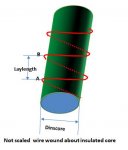INGMRS
Member
- Location
- san jose, Costa Rica, code NEC USA
Hello,
I am trying to calculate the resistance of a concentric neutral with a helically configuration for a medium voltage conductor with copper wires.
However, I can not find a correct formula to calculate the "lay factor."
I wonder if some of you have made this calculation before and could help me?, I do not understand the manufacturer's explanation.
The cable is a #1/0 AWG, EPR, 34.kV, CU
Attached is my spreadsheet, also is attached the explanation of the manufacturer for the lay factor calculation.
Regards,
I am trying to calculate the resistance of a concentric neutral with a helically configuration for a medium voltage conductor with copper wires.
However, I can not find a correct formula to calculate the "lay factor."
I wonder if some of you have made this calculation before and could help me?, I do not understand the manufacturer's explanation.
The cable is a #1/0 AWG, EPR, 34.kV, CU
Attached is my spreadsheet, also is attached the explanation of the manufacturer for the lay factor calculation.
Regards,



